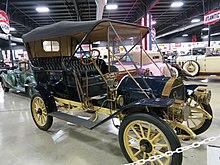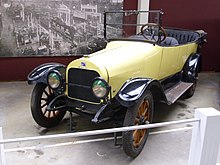WA Paterson Company
| WA Paterson Company | |
|---|---|
| legal form | Company |
| founding | 1869 |
| resolution | 1923 |
| Seat | Flint , Michigan , USA |
| management | WC Paterson |
| Branch | vehicles |
WA Paterson Company was an American manufacturer of vehicles .
Company history
William A. Paterson was born in Canada in 1838 . He founded the company in Flint , Michigan in 1869 . At first he made carriages . In 1907 the first prototype of an automobile was created . Series production began in December 1908. The brand name was Paterson . Carriage production ended in 1910. EC Kollmorgen was an engineering and production manager from around 1914. In the best of 1920, over 2000 vehicles were built. There were sales offices in 48 US states.
William A. Paterson died in September 1921. His son WC Paterson and WR Hubbard now ran the company. They fought against the post-war depression. In July 1923 they sold the company to Dallas Winslow, who ran a dealership for Dodge in the same town. His plans to continue production failed.
vehicles
In 1909 there was only the Model 14 . It is described as a motor buggy . An air-cooled two-cylinder engine with 14 hp powered the rear axle via a planetary gearbox and two chains. The solid rubber tires were striking . The chassis had a wheelbase of 203 cm .
In 1910 a more modern vehicle appeared with the Model 30 . It had a four-cylinder engine with 30 hp, an ordinary manual gearbox and cardan drive . The wheelbase was 264 cm. There was a choice of touring cars with five seats, Demi-Tonneau with four seats and Tourabout with four seats.
In 1911 this model was further developed. The wheelbase has been lengthened to 269 cm for four versions. These were Model A as a five-seat touring car, Model B as a four-seat demi-tonneau, Model C as a four-seat Tourabout and Model F as a two-seat roadster . Two versions had 279 cm wheelbase, front doors and probably touring car bodies. The Model E was four-seater and the other, handed down by the no model name, fünfsitzig. In addition, the Model 38 was released as Model G that year . Its four-cylinder engine developed 38 hp. The wheelbase of 300 cm enabled it to be built as a five-seater touring car.
In 1912 the Model 35 was the smaller of two models. His data were 30 hp, a 274 cm wheelbase and a touring car body with five seats. The Model 45 had a 45 hp engine, 305 cm wheelbase and a touring car body with either five or seven seats.
In 1913, the Model 41 and 43 had the same dates. The engine was specified with 40 hp. The wheelbase measured 295 cm. The open touring car offered space for five people. The Model 47 was a little more powerful with 45 hp, a little longer with a 310 cm wheelbase and was bodied as a seven-seater touring car.
In 1914 the range was limited to a model series with a 32 hp engine and a 284 cm wheelbase. Model 32 was a two-seat roadster and Model 33 was a five-seat touring car.
In 1915 this model became the Model 4-32 . The wheelbase was now 297 cm. A runabout and a touring car were available. In addition, the Model 6-48 was a vehicle with a six-cylinder engine from the Continental Motors Company . It was specified with 40 hp. The wheelbase corresponded to the four-cylinder model. The structure was a five-seater touring car.
In 1916, the wheelbase of the Model 4-32 was shortened to 284 cm. The runabout was omitted while the touring car had five seats. No wheelbase has survived for the six-cylinder model. It was available as a five- and seven-seater touring car.
The four-cylinder model was discontinued in 1917. The Model 6-45 had 40 hp and a 297 cm wheelbase. Touring cars with five and seven seats and a roadster with four seats are known.
In 1918, a five-seater limousine added to the superstructures available. This was Paterson's first closed car body.
In 1919 only the wheelbase changed to 305 cm.
The Model 6-47 followed in 1920 . The engine output had been increased to 42 hp. Touring cars with five and seven seats, sedans with six and seven seats and, for the first time, a coupé with five seats were available.
In 1921 it became the Model 6-50 . The engine was now specified with 55 hp. The limousine now had five seats again.
In 1922 there were no changes to the dates. However, the vehicle was now called Model 22 .
In 1923 there were six bodies to choose from. These were touring cars with five and seven seats, a sedan with five seats, a coupe with four seats, a sport with five seats and a brougham with also five seats.
Model overview
| year | model | execution | cylinder | Power ( hp ) | Wheelbase (cm) | construction |
|---|---|---|---|---|---|---|
| 1909 | Model 14 | 2 | 14th | 203 | Motor buggy | |
| 1910 | Model 30 | 4th | 30th | 264 | Touring car 5-seat, Demi-Tonneau 4-seat, Tourabout 4-seat | |
| 1911 | Model 30 | Model A | 4th | 30th | 269 | 5-seater touring car |
| 1911 | Model 30 | Model B | 4th | 30th | 269 | Demi-Tonneau 4-seater |
| 1911 | Model 30 | Model C | 4th | 30th | 269 | Tourabout 4-seater |
| 1911 | Model 30 | Model E. | 4th | 30th | 279 | Fore-Door 4-seater |
| 1911 | Model 30 | Model F | 4th | 30th | 269 | Roadster 2-seater |
| 1911 | Model 30 | 4th | 30th | 279 | Fore-Door 5-seater | |
| 1911 | Model 38 | Model G | 4th | 38 | 300 | Fore-Door touring car, 5-seater |
| 1912 | Model 35 | 4th | 30th | 274 | 5-seater touring car | |
| 1912 | Model 45 | 4th | 45 | 305 | 5-seater and 7-seater touring cars | |
| 1913 | Model 41 | 4th | 40 | 295 | 5-seater touring car | |
| 1913 | Model 43 | 4th | 40 | 295 | 5-seater touring car | |
| 1913 | Model 47 | 4th | 45 | 310 | 7-seater touring car | |
| 1914 | Model 32 | 4th | 32 | 284 | Roadster 2-seater | |
| 1914 | Model 33 | 4th | 32 | 284 | 5-seater touring car | |
| 1915 | Model 4-32 | 4th | 32 | 297 | Runabout, touring car | |
| 1915 | Model 6-48 | 6th | 40 | 297 | 5-seater touring car | |
| 1916 | Model 4-32 | 4th | 32 | 284 | 5-seater touring car | |
| 1916 | Model 6-42 | 6th | 40 | 5-seater and 7-seater touring cars | ||
| 1917 | Model 6-45 | 6th | 40 | 297 | 5-seater and 7-seater touring cars, 4-seater roadsters | |
| 1918 | Model 6-45 | 6th | 40 | 297 | 5-seater and 7-seater touring cars, 4-seater roadsters, 5-seater sedans | |
| 1919 | Model 6-45 | 6th | 40 | 305 | 5-seater and 7-seater touring cars, 4-seater roadsters, 5-seater sedans | |
| 1920 | Model 6-47 | 6th | 42 | 305 | 5-seater and 7-seater touring cars, 6-seater and 7-seater sedans, 5-seater coupé | |
| 1921 | Model 6-50 | 6th | 55 | 305 | 5-seater and 7-seater touring cars, 5-seater coupé, 5-seater sedan | |
| 1922 | Model 22 | 6th | 55 | 305 | 5-seater sedan, 5-seater coupé, 5-seater and 7-seater touring cars | |
| 1923 | Model 23 | 6th | 55 | 305 | Touring car 5-seat and 7-seat, sedan 5-seat, coupé 4-seat, Sport 5-seat, Brougham 5-seat |
Source:
Production numbers
| year | Production number |
|---|---|
| 1909 | 163 |
| 1910 | 233 |
| 1911 | 293 |
| 1912 | 424 |
| 1913 | 349 |
| 1914 | 419 |
| 1915 | 574 |
| 1916 | 983 |
| 1917 | 1,985 |
| 1918 | 635 |
| 1919 | 1,630 |
| 1920 | 2.013 |
| 1921 | 1,483 |
| 1922 | 906 |
| 1923 | 562 |
| total | 12,652 |
Source:
literature
- Beverly Rae Kimes, Henry Austin Clark Jr .: Standard catalog of American Cars. 1805-1942. Digital edition . 3. Edition. Krause Publications, Iola 2013, ISBN 978-1-4402-3778-2 , pp. 1154-1156 (English).
- George Nicholas Georgano (Ed.): The Beaulieu Encyclopedia of the Automobile . Volume 3: P-Z . Fitzroy Dearborn Publishers, Chicago 2001, ISBN 1-57958-293-1 , pp. 1197 (English).
Web links
Individual evidence
- ↑ a b c Beverly Rae Kimes, Henry Austin Clark Jr .: Standard catalog of American Cars. 1805-1942. Digital edition . 3. Edition. Krause Publications, Iola 2013, ISBN 978-1-4402-3778-2 , pp. 1154-1156 (English).
- ↑ a b George Nicholas Georgano (Ed.): The Beaulieu Encyclopedia of the Automobile . Volume 3: P-Z . Fitzroy Dearborn Publishers, Chicago 2001, ISBN 1-57958-293-1 , pp. 1197 (English).


